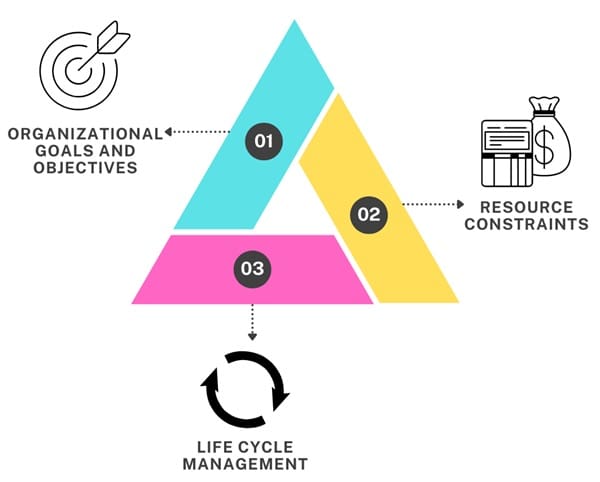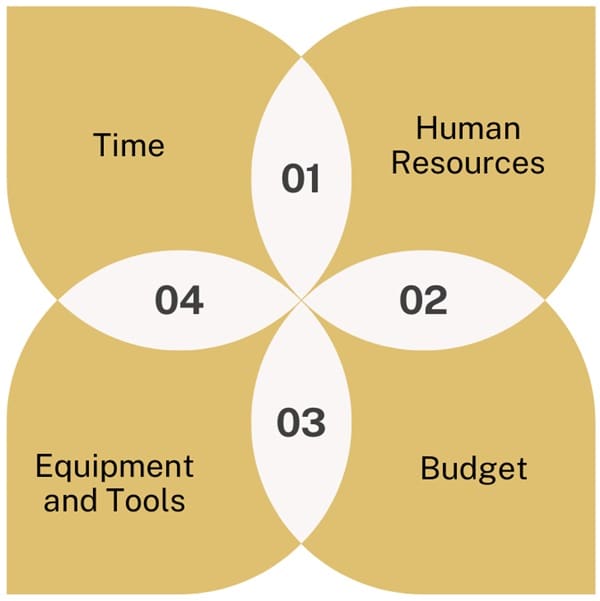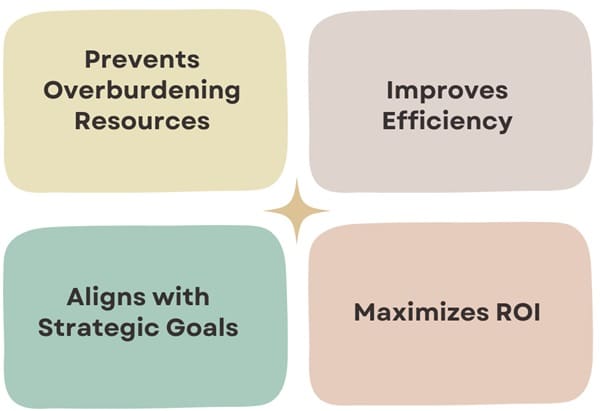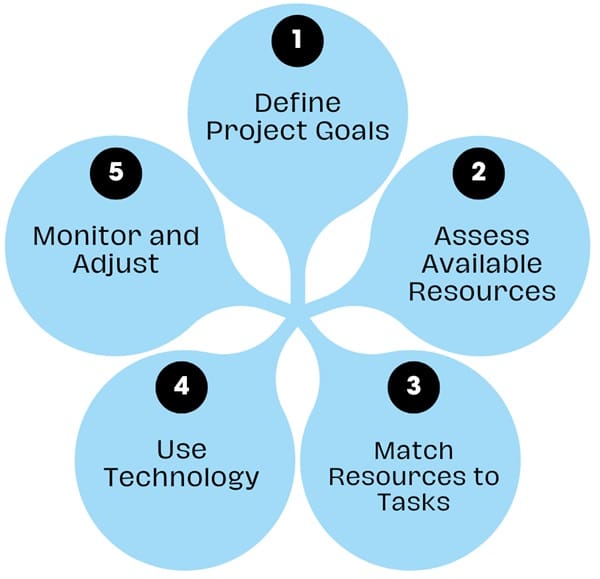Resource allocation is a critical aspect of any project or business initiative. It refers to the process of assigning and managing assets—both tangible and intangible—in a way that maximizes their utility and aligns with the organization’s strategic objectives.
In its most basic form, it involves the distribution of finite resources, such as budget, personnel, and equipment, to ensure the successful execution of a project or task. However, the practice is much broader than just distribution; it includes planning, tracking, evaluating, and adjusting resources to optimize performance and achieve desired outcomes.
Table of contents
Defining Resource Allocation
Resource allocation is the method of distributing and managing assets to meet business goals efficiently. These assets include anything from human capital (people and their skills) to equipment, budgets, time, and even intellectual resources.
The primary goal of resource allocation is to use available resources effectively to deliver projects on time, within scope, and within budget while achieving maximum return on investment (ROI).
In any business or project environment, organizations often face limited resources, meaning they must make careful decisions about how and where to allocate them. Successful resource allocation leads to better productivity, higher efficiency, and improved overall performance. By contrast, poor resource allocation can cause delays, increased costs, and even project failure.
At its core, it involves assigning available resources to different investments or projects. These resources may include money, staff, equipment, or contractor capacity. The aim is to ensure the best use of these limited resources, often requiring tough decisions about prioritizing projects.
For instance, a transportation agency might need to decide how much money to allocate for highway maintenance versus new construction. This decision is not only about available funds but also about long-term goals, such as improving safety or increasing road capacity.
Factors influencing Resource Allocation

- Organizational Goals and Objectives: What are the agency’s main priorities? Are they more focused on improving infrastructure or maintaining existing assets?
- Resource Constraints: Most organizations don’t have unlimited resources. Therefore, they must prioritize projects based on budget limitations, workforce availability, and other resource shortages.
- Life Cycle Management: This involves considering the long-term management of assets, like roads and bridges, to ensure they stay in good condition over their lifespan.
Key Elements

It is a multi-faceted process that involves various key elements, each essential for successful execution:
- Human Resources: This includes team members, their skills, knowledge, and time. Ensuring that the right people with the right skills are assigned to the right tasks is a key aspect of resource allocation.
- Budget: Financial resources are often the most constrained. Wisely allocating money across different areas of a project ensures that all tasks can be completed without exceeding the budget.
- Equipment and Tools: Physical resources like computers, machinery, or software tools are equally important. Effective allocation ensures that the right tools are available at the right time for project execution.
- Time: Time is one of the most critical resources. Allocating time efficiently involves scheduling work to avoid bottlenecks and delays.
Why is Resource Allocation Important?

Effective resource allocation is vital for several reasons:
- Prevents Overburdening Resources: Proper allocation distributes work evenly, ensuring team members avoid overwork and burnout.
- Improves Efficiency: Assigning the right resources to the right tasks at the right time enhances productivity and ensures tasks are completed efficiently.
- Maximizes ROI: Organizations maximize their return on investment by using resources optimally through effective allocation.
- Aligns with Strategic Goals: It aligns projects and tasks with the company’s broader strategic objectives, such as increasing revenue, enhancing brand recognition, or improving productivity.
Resource Allocation Process
The process of allocating resources typically involves five key steps, particularly in project management:
typical resource allocation process consists of several key steps. The steps may vary depending on the organization’s needs and the types of resources being allocated. But the general process is often similar across different organizations.
Step 1: Define Goals and Objectives
The first step is to clearly define the agency’s goals and objectives. For example, a transportation agency might prioritize safety improvements, increasing capacity, or maintaining existing infrastructure. These objectives guide every subsequent decision in the resource allocation process.
Step 2: Assess Available Resources
Next, the organization must assess what resources are available. This includes both financial resources (such as budgets and grants) and non-financial resources (such as workforce availability and equipment). A comprehensive assessment helps ensure that the allocation process is realistic and achievable.
Step 3: Identify Performance Targets
Once goals are established and resources assessed, the agency must set performance targets. These targets provide measurable outcomes that the agency hopes to achieve with the allocated resources. For example, a performance target might be to reduce the number of roads in poor condition by 10% over the next five years.
Step 4: Develop a Resource Allocation Plan
After setting performance targets, the agency creates a resource allocation plan. This plan outlines how the organization will distribute resources to meet both short-term and long-term objectives. The plan may specify how much money the organization will allocate to certain projects or how it will assign personnel to various tasks.
Step 5: Monitor Progress
Once the plan is in place, the agency must continuously monitor its progress. This involves tracking whether resources are being used effectively and whether performance targets are being met. Regular monitoring allows the agency to make adjustments as needed.
Step 6: Review and Adjust
Based on the monitoring process, the agency may need to review and adjust its resource allocation plan. For example, if a particular project is not yielding the expected results, the agency might reallocate resources to a different project or adjust the performance targets.
Step 7: Evaluate Long-Term Outcomes
Finally, the agency evaluates the long-term outcomes of its resource allocation decisions. This helps inform future resource allocation processes, ensuring that the agency continually improves its ability to meet its goals with the resources available.
Resource Allocation in Different Contexts
While resource allocation is a staple in project management, it applies to other areas as well, such as economics and computing:
- Economics: In the realm of public finance, resource allocation refers to how a government or economy decides to distribute resources—such as land, labor, and capital—to optimize social welfare.
- Computer Storage: In computing, resource allocation refers to how operating systems assign memory, storage, and processing power to applications to optimize performance.
Resource Allocation vs. Scheduling
It is crucial to distinguish between resource allocation and scheduling, though they are closely related. Resource allocation involves selecting the appropriate resources and determining how they will be used in a project. Scheduling, on the other hand, is the process of assigning those resources to specific tasks over time.
Resource scheduling ensures that resources are available when needed, and it takes into account various constraints such as deadlines and availability.
How to Allocate Resources Effectively?

Allocating resources effectively is more than just assigning tasks. It requires strategic thinking and detailed planning:
- Define Project Goals: Start by identifying the key objectives of the project. The goals will serve as a guide when deciding how to allocate resources.
- Assess Available Resources: Understand what resources are available, including team members, budgets, equipment, and time. It’s essential to know both the quantity and quality of available resources to make informed allocation decisions.
- Match Resources to Tasks: Assign resources based on their strengths and relevance to the project. This is crucial for ensuring that the right people and tools are used for the right tasks.
- Use Technology: Resource management tools can automate many aspects of resource allocation, including scheduling and tracking. This ensures that resources are used efficiently and helps identify potential issues before they become problems.
- Monitor and Adjust: It is not a one-time process. It requires ongoing monitoring to ensure that resources are being used effectively. Adjustments may be necessary as the project progresses or as new challenges arise.
Benefits of Effective Resource Allocation
When done correctly, resource allocation brings several significant benefits to an organization:
- Staff Retention: A well-executed resource allocation process can lead to higher employee satisfaction by preventing burnout and fostering a healthy work-life balance. It also allows employees to develop their skills and advance in their careers.
- Client Satisfaction: Clients expect to work with teams that have the necessary expertise to deliver high-quality results. Effective resource allocation ensures that the right skills are matched with client needs, leading to better project outcomes and increased client satisfaction.
- Profitable Projects: Allocating resources efficiently helps reduce unnecessary costs and ensures that projects are completed on time and within budget. This, in turn, improves profitability by reducing the risks of delays and cost overruns.
- Resource Optimization: Optimal allocation involves using both physical and human resources in the most effective way possible. This improves project outcomes and ensures that projects meet their objectives.
Challenges in Resource Allocation
Although it is essential, it comes with its own set of challenges:
- Limited Resources: The most significant challenge in this is dealing with limited resources. Whether it’s a lack of personnel, budget, or time, managers often face the difficult task of making do with less than they would ideally have.
- Changing Priorities: In dynamic business environments, priorities can shift rapidly. Managers must constantly adjust resource allocations to meet new demands or take advantage of emerging opportunities.
- Conflicting Interests: Different stakeholders often have competing needs. Balancing these interests while still optimizing resource use can be challenging.
- Resource Availability: Managing the availability of resources—especially human resources—can be difficult. Team members may have other commitments, such as working on multiple projects, which can impact their availability.
Final Words
Resource allocation is a vital process for ensuring the success of any project or business initiative. By strategically assigning resources like human capital, budget, and equipment, organizations can optimize efficiency, improve productivity, and achieve their goals more effectively.
Although resource allocation comes with challenges such as limited resources and shifting priorities, organizations can overcome these obstacles by following a structured and flexible allocation process. Effective resource allocation not only benefits individual projects but also contributes to the overall growth and success of the organization, fostering client satisfaction, team engagement, and profitability.


















